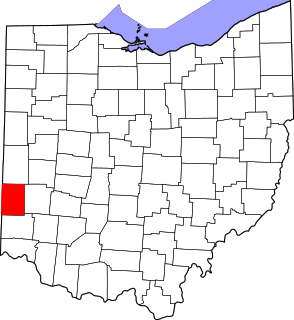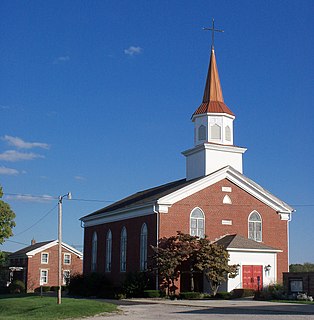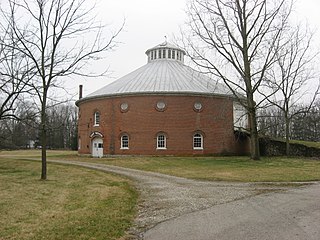Dr. Adam Mosgrove House | |
Front of the house | |
| Location | 127 Miami St., Urbana, Ohio |
|---|---|
| Coordinates | 40°6′29″N83°45′14″W / 40.10806°N 83.75389°W Coordinates: 40°6′29″N83°45′14″W / 40.10806°N 83.75389°W |
| Area | less than one acre |
| Built | 1833 |
| Architectural style | Federal, Greek Revival |
| NRHP reference # | 82003550 [1] |
| Added to NRHP | July 15, 1982 |
The Dr. Adam Mosgrove House is a historic house in Urbana, Ohio, United States. Located along Miami Street (U.S. Route 36 [2] ) on the city's western side, [1] it was built in 1833 as the home of physician Adam Mosgrove, one of Urbana's first doctors. A native of Enniskillen in Ireland, Mosgrove immigrated to the United States in 1816; he moved to Urbana after living in Elizabethtown and Lancaster, Ohio. [3] :120

Urbana is a city in and the county seat of Champaign County, Ohio, United States, 47 miles (76 km) west of Columbus. Urbana was laid out in 1805, and for a time in 1812 was the headquarters of the Northwestern army during the War of 1812. It is the burial place of the explorer and Indian fighter Simon Kenton.

Ohio is a Midwestern state in the Great Lakes region of the United States. Of the fifty states, it is the 34th largest by area, the seventh most populous, and the tenth most densely populated. The state's capital and largest city is Columbus.

The United States of America (USA), commonly known as the United States or America, is a country composed of 50 states, a federal district, five major self-governing territories, and various possessions. At 3.8 million square miles, the United States is the world's third or fourth largest country by total area and is slightly smaller than the entire continent of Europe's 3.9 million square miles. With a population of over 327 million people, the U.S. is the third most populous country. The capital is Washington, D.C., and the largest city by population is New York City. Forty-eight states and the capital's federal district are contiguous in North America between Canada and Mexico. The State of Alaska is in the northwest corner of North America, bordered by Canada to the east and across the Bering Strait from Russia to the west. The State of Hawaii is an archipelago in the mid-Pacific Ocean. The U.S. territories are scattered about the Pacific Ocean and the Caribbean Sea, stretching across nine official time zones. The extremely diverse geography, climate, and wildlife of the United States make it one of the world's 17 megadiverse countries.
A two-and-one-half-story structure, the brick house is a simple rectangle built upon a stone foundation. [3] :120 Its style is predominately Federal, although the entrance is strongly Greek Revival, [3] :119 featuring pilasters topped with Doric capitals. [3] :120 As one of Urbana's oldest houses, [3] :119 and as the home of one of its leading early citizens, the Mosgrove House has been seen as historically significant; [3] :120 for this reason, it was listed on the National Register of Historic Places in 1982. [1]

A storey or story is any level part of a building with a floor that could be used by people. The plurals are "storeys" and "stories", respectively.

In engineering, a foundation is the element of a structure which connects it to the ground, and transfers loads from the structure to the ground. Foundations are generally considered either shallow or deep. Foundation engineering is the application of soil mechanics and rock mechanics in the design of foundation elements of structures.

Federal-style architecture is the name for the classicizing architecture built in the newly founded United States between c. 1780 and 1830, and particularly from 1785 to 1815. This style shares its name with its era, the Federalist Era. The name Federal style is also used in association with furniture design in the United States of the same time period. The style broadly corresponds to the classicism of Biedermeier style in the German-speaking lands, Regency architecture in Britain and to the French Empire style.






















